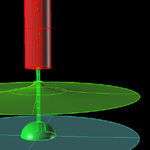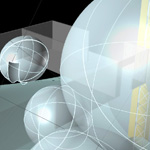Christmas In July
 Thursday, July 2, 2009 at 2:33PM
Thursday, July 2, 2009 at 2:33PM The project presented here was not sanctioned by, coordinated with or reviewed by MOS Architect's or PS1. Having spent considerable time working with the site, program requirements and analysis of MOS's Afterparty scheme I was inspired to created a parametric study of my own. The goal was to utilize environmental simulation to generate a set of "design criteria" prior to embarking on the installation design. The study attempts to work within the budget limitations and requirements of the PS1 Young Architect's Program.
 Stack effect occurs when a pressure differential is created within an enclosed or airflow-restricted volume. Higher-temperature air at the top of the volume rises creating a vacuum which draws on the cooler, lower temp air creating below. There are a handful of factors to maximize the flow of air within a tower and these became the parameters I studied in IES. Those parameters were; tower height, stack and room volume, air temperature and the opening's size, number and orientation. The study proceeded by creating a base-case model which was the simplified MOS tower design. Then by applying a single intervention to create a new study model. Each study model was then simulated with a range of values for that intervention. Given the total set of resulting models and data the best values for each intervention was applied to the base-case model to create a measure of overall performance improvement.
Stack effect occurs when a pressure differential is created within an enclosed or airflow-restricted volume. Higher-temperature air at the top of the volume rises creating a vacuum which draws on the cooler, lower temp air creating below. There are a handful of factors to maximize the flow of air within a tower and these became the parameters I studied in IES. Those parameters were; tower height, stack and room volume, air temperature and the opening's size, number and orientation. The study proceeded by creating a base-case model which was the simplified MOS tower design. Then by applying a single intervention to create a new study model. Each study model was then simulated with a range of values for that intervention. Given the total set of resulting models and data the best values for each intervention was applied to the base-case model to create a measure of overall performance improvement.
(Click the thumbnail to see diagrams of the parametric study)
 The result of this analysis was a very refined set of criteria which I used as the basis for the design of a an installation I dubbed, Christmas in July. The design centers around two towers which are approximately 95' tall. This height is achieved, within the budget of the program, by utilizing off-the-shelf and pre-engineered, radio towers. The analysis dictated, that to be effective, 100% coverage from the sun was required to isolate the "cooling" chambers at the ground level. Therefore, the towers are covered as if they were standard tents but the material would be printed to look like Finnish winter camouflage. Cladding the tops of the towers in metal turned out to be the most effective strategy to maximize the heat differential. I chose copper such as would traditionally used to flash a slate roof. The metal covers the towers from about 30 feet to the tip. In addition to the copper cladding, a "greenhouse" is created around the flashing by the "bubbles" which wrap around the top of the structure. These could be inflatable and allowed to swell and deflate as they heat and cool or be made over a rigid framework. Very clear, recyclable, PETG film would be used to create bubbles.
The result of this analysis was a very refined set of criteria which I used as the basis for the design of a an installation I dubbed, Christmas in July. The design centers around two towers which are approximately 95' tall. This height is achieved, within the budget of the program, by utilizing off-the-shelf and pre-engineered, radio towers. The analysis dictated, that to be effective, 100% coverage from the sun was required to isolate the "cooling" chambers at the ground level. Therefore, the towers are covered as if they were standard tents but the material would be printed to look like Finnish winter camouflage. Cladding the tops of the towers in metal turned out to be the most effective strategy to maximize the heat differential. I chose copper such as would traditionally used to flash a slate roof. The metal covers the towers from about 30 feet to the tip. In addition to the copper cladding, a "greenhouse" is created around the flashing by the "bubbles" which wrap around the top of the structure. These could be inflatable and allowed to swell and deflate as they heat and cool or be made over a rigid framework. Very clear, recyclable, PETG film would be used to create bubbles.
(Click the thumbnail to see the design sketches)
 I wanted to further demonstrate the power of architecture to modify the environment and to do so felt that creating a few "hot" rooms to counteract the "cool" rooms created by the towers was a good way to do so. Using the same materials and design language for the "greenhouse bubbles", a few rooms are created which visitors can go into and experience the power of the sun. These would be strategically placed by the front entrance of the courtyard to entice visitors to "heat up" prior to be "cooled down" later in the experience.
I wanted to further demonstrate the power of architecture to modify the environment and to do so felt that creating a few "hot" rooms to counteract the "cool" rooms created by the towers was a good way to do so. Using the same materials and design language for the "greenhouse bubbles", a few rooms are created which visitors can go into and experience the power of the sun. These would be strategically placed by the front entrance of the courtyard to entice visitors to "heat up" prior to be "cooled down" later in the experience.
(Click the thumbnail to see the design sketches)
 Bill | Comments Off |
Bill | Comments Off | 